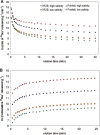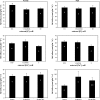Futile Na+ cycling at the root plasma membrane in rice (Oryza sativa L.): kinetics, energetics, and relationship to salinity tolerance
- PMID: 18854575
- PMCID: PMC2639017
- DOI: 10.1093/jxb/ern249
Futile Na+ cycling at the root plasma membrane in rice (Oryza sativa L.): kinetics, energetics, and relationship to salinity tolerance
Abstract
Globally, over one-third of irrigated land is affected by salinity, including much of the land under lowland rice cultivation in the tropics, seriously compromising yields of this most important of crop species. However, there remains an insufficient understanding of the cellular basis of salt tolerance in rice. Here, three methods of 24Na+ tracer analysis were used to investigate primary Na+ transport at the root plasma membrane in a salt-tolerant rice cultivar (Pokkali) and a salt-sensitive cultivar (IR29). Futile cycling of Na+ at the plasma membrane of intact roots occurred at both low and elevated levels of steady-state Na+ supply ([Na+]ext=1 mM and 25 mM) in both cultivars. At 25 mM [Na+]ext, a toxic condition for IR29, unidirectional influx and efflux of Na+ in this cultivar, but not in Pokkali, became very high [>100 micromol g (root FW)(-1) h(-1)], demonstrating an inability to restrict sodium fluxes. Current models of sodium transport energetics across the plasma membrane in root cells predict that, if the sodium efflux were mediated by Na+/H+ antiport, this toxic scenario would impose a substantial respiratory cost in IR29. This cost is calculated here, and compared with root respiration, which, however, comprised only approximately 50% of what would be required to sustain efflux by the antiporter. This suggests that either the conventional 'leak-pump' model of Na+ transport or the energetic model of proton-linked Na+ transport may require some revision. In addition, the lack of suppression of Na+ influx by both K+ and Ca2+, and by the application of the channel inhibitors Cs+, TEA+, and Ba2+, questions the participation of potassium channels and non-selective cation channels in the observed Na+ fluxes.
Figures






Similar articles
-
Membrane fluxes, bypass flows, and sodium stress in rice: the influence of silicon.J Exp Bot. 2018 Mar 24;69(7):1679-1692. doi: 10.1093/jxb/erx460. J Exp Bot. 2018. PMID: 29342282 Free PMC article.
-
K+ efflux and retention in response to NaCl stress do not predict salt tolerance in contrasting genotypes of rice (Oryza sativa L.).PLoS One. 2013;8(2):e57767. doi: 10.1371/journal.pone.0057767. Epub 2013 Feb 27. PLoS One. 2013. PMID: 23460903 Free PMC article.
-
Rice cultivars with differing salt tolerance contain similar cation channels in their root cells.J Exp Bot. 2012 May;63(8):3289-96. doi: 10.1093/jxb/ers052. Epub 2012 Feb 17. J Exp Bot. 2012. PMID: 22345644 Free PMC article.
-
Comparing Essentiality of SOS1-Mediated Na+ Exclusion in Salinity Tolerance between Cultivated and Wild Rice Species.Int J Mol Sci. 2022 Aug 31;23(17):9900. doi: 10.3390/ijms23179900. Int J Mol Sci. 2022. PMID: 36077294 Free PMC article.
-
Sodium efflux in plant roots: what do we really know?J Plant Physiol. 2015 Aug 15;186-187:1-12. doi: 10.1016/j.jplph.2015.08.002. Epub 2015 Aug 15. J Plant Physiol. 2015. PMID: 26318642 Review.
Cited by
-
A Comprehensive Biophysical Model of Ion and Water Transport in Plant Roots. II. Clarifying the Roles of SOS1 in the Salt-Stress Response in Arabidopsis.Front Plant Sci. 2019 Sep 18;10:1121. doi: 10.3389/fpls.2019.01121. eCollection 2019. Front Plant Sci. 2019. PMID: 31620152 Free PMC article.
-
The Thermodynamic Flow-Force Interpretation of Root Nutrient Uptake Kinetics: A Powerful Formalism for Agronomic and Phytoplanktonic Models.Front Physiol. 2016 Jun 27;7:243. doi: 10.3389/fphys.2016.00243. eCollection 2016. Front Physiol. 2016. PMID: 27445836 Free PMC article. Review.
-
The role of a potassium transporter OsHAK5 in potassium acquisition and transport from roots to shoots in rice at low potassium supply levels.Plant Physiol. 2014 Oct;166(2):945-59. doi: 10.1104/pp.114.246520. Epub 2014 Aug 25. Plant Physiol. 2014. PMID: 25157029 Free PMC article.
-
Measuring fluxes of mineral nutrients and toxicants in plants with radioactive tracers.J Vis Exp. 2014 Aug 22;(90):51877. doi: 10.3791/51877. J Vis Exp. 2014. PMID: 25177829 Free PMC article.
-
The Role of Na+ and K+ Transporters in Salt Stress Adaptation in Glycophytes.Front Physiol. 2017 Jul 18;8:509. doi: 10.3389/fphys.2017.00509. eCollection 2017. Front Physiol. 2017. PMID: 28769821 Free PMC article. Review.
References
-
- Amtmann A, Gradmann D. Na+ transport in Acetabularia bypasses conductance of plasmalemma. Journal of Membrane Biology. 1994;139:117–125. - PubMed
-
- Anil VS, Krishnamurthy P, Kuruvilla S, Sucharitha K, Thomas G, Mathew MK. Regulation of the uptake and distribution of Na+ in shoots of rice (Oryza sativa) variety Pokkali: role of Ca2+ in salt tolerance response. Physiologia Plantarum. 2005;124:451–464.
-
- Apse MP, Aharon GS, Snedden WA, Blumwald E. Overexpression of a vacuolar Na+/H+ antiport confers salt tolerance in Arabidopsis. Science. 1999;285:1256–1258. - PubMed
-
- Apse MP, Blumwald E. Na+ transport in plants. FEBS Letters. 2007;581:2247–2254. - PubMed
Publication types
MeSH terms
Substances
LinkOut - more resources
Full Text Sources
Miscellaneous

